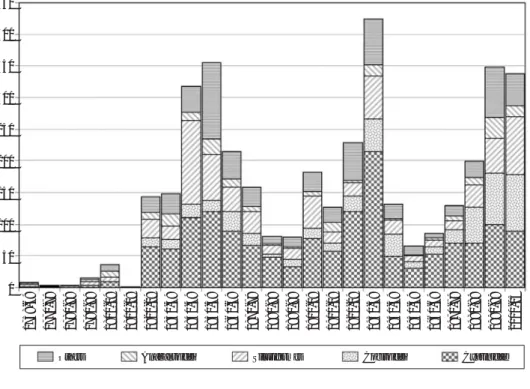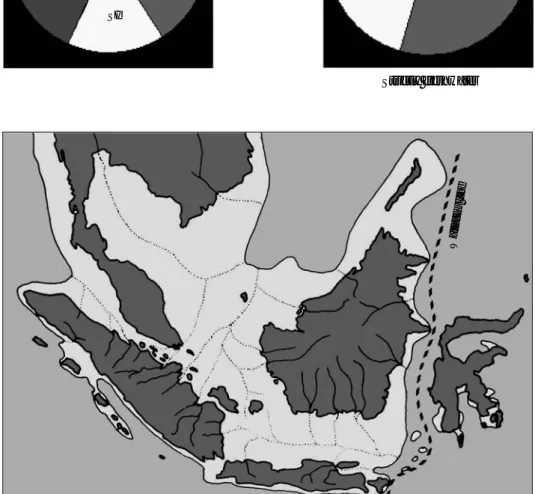—3—
The history of biodiversity research in the freshwaters of Southeast Asia starts with the publication by Bontius in 1642 of a plate representing a fish labelled ‘tinca ma- rina’ (the ‘marine tench’, now known as Notopterus noto- pterus). Between the beginning of Linnaean nomencla- ture in 1758 and April 2009, 6614 nominal species have been described from inland waters (fresh waters, estuar- ies, inland mangroves) of Southeast Asia (pers. obs.).
(Southeast Asia refers here to the area on the mainland between and including the Irrawaddy and Red River drainage, Indonesia eastwards to Bali and Sulawesi, the Philippines and Hainan Island). The discovery and des- cription of new species shows three peaks (Fig. 1), one in the years 1840~1870 (870 nominal species, due main- ly to the activity of Pieter Bleeker during his stay in Java),
in 1920~1940 (about 650 nominal species, mainly ob- tained by expeditions organised by large American and European institutions, and work by colonial administra- tions) and in 1990~2005 (about 700 nominal species).
In a not yet published checklist, I consider that 2878 of these 6614 nominal species are valid. About 2200 are stictly freshwater species and about 680 are brackish water species and marine species more or less frequently entering inland waters.
There are about 300 additional species present on mu- seum shelves but which are still unnamed and around 200 nominal species presently treated as synonyms that are likely to in fact represent valid species. A reasonable guess is that up to 600 species may still await discovery in the inland waters of the area, especially in Myanmar,
Diversity of Freshwater Fishes in Southeast Asia
By Maurice Kottelat
Route de la Baroche 12, Case Postale 57, 2952 Cornol, Switzerland (permanent address), and Honorary Research Associate, Raffles Museum of Biodiversity Research, Department of Biological Sciences, National University of Singapore, Lower Kent Ridge Road, Singapore 119260, Republic of Singapore
KOREAN JOURNAL OF ICHTHYOLOGY, Vol. 21 Supplement, 3-6, July 2009 ISSN: 1225-8598
Received : April 18, 2009 Revised : June 23, 2009 Accepted : July 17, 2009
http://www.fishkorea.or.kr
Others Anabantoidei Siluriformes Cobitoidei Cyprinidae
Fig. 1. Species descriptions of South- east Asian freshwater fishes, distri- buted in periods of 10 years, between 1758 and 2005.
1758-69 1770-79 1780-89 1790-99 1800-09 1810-19 1820-29 1830-39 1840-49 1850-59 1860-69 1870-79 1880-89 1890-99 1900-09 1910-19 1920-29 1930-39 1940-49 1950-59 1960-69 1970-79 1980-89 1990-99 2000-05
450 400 350 300 250 200 150 100 50 0
*Corresponding author: Maurice Kottelat Tel: +41-032-462-3175, Fax: +41-032-462-2259, E-mail: mkottelat@dplanet.ch
Vietnam, Laos, Borneo and the Philippines. This brings to an estimated total of 4000 species.
This diversity is made mainly by Ostariophysi, of which about 1000 are Cypriniformes (of which 350 Cob- itoidei) and 370 Siluriformes. About 700 are Perciformes (especially Gobioidei and Anabantoidei) (Fig. 2). About 95 families are recorded in inland waters of southeast Asia, much more than in any other area of the world. A great number of them are mostly marine with a few or a single freshwater species, or are represented only by species more or less frequently observed inland. This great number of families (and marine visitors) is explain- ed by several factors, including:
1) the area is surrounded by the richest and most diver- se marine fauna of the world;
2) the huge and shallow Sunda shelf, with a low salin- ity, surrounded by land masses with numerous rivers with high discharge (Fig. 3) apparently allowed an easier access by marine families into inland waters;
3) the river drainages of most areas outside the Sunda Shelf are flowing to deep marine areas (e.g. Sulawesi, Eastern Borneo, the southern coast of Sumatra and Java, the Philippines) and have had only very limited connec- tions with other river drainages; as a result their fauna is made of only few species of the primary freshwater fami- lies, allowing marine species to occupy freshwater niches and habitats that remained empty.
As an example of the magnitude of the discoveries done in recent years, I can refer to my work done in Laos. 216 species had been recorded (Taki, 1974) from
4 Maurice Kottelat
Fig. 2. Composition of the inland fish fauna of Southeast Asia. A, total inland fauna (including estuarine, brackfish and occasional species); B, strictly freshwater species. CY, Cyp- riniformes; SI, Siluriformes; CP, Cyp- rinodontiformes, Atheriniformes, Mu- giliformes, Beloniformes; PE, Perci- formes; OT, others.
Fig. 3. Sundaland, about 12,000 yeara BP. Dark gray: present emerged;
white: present submerged, but emerg- ed during glaciations; soft gray: sea level during glaciations. Dotted lines represent river course during glacia- tions.
Strictly freshwater
A B
OT
CY
SI PE
CP
Wallace’s line
Diversity of Freshwater Fishes in Southeast Asia 5
this country before I started my work in 1996; actually most were recorded from the Mekong main river were it makes the international border between Laos and Thai- land; any species recorded from the Thai shore could log- ically be expected on the Lao shore too. By the end of 1997 they were 370, by the end of 2000 they were 481 (Kottelat, 2001). Their number now is about 510 named species (unpubl. data). 131 new species were described between 1996 and 2001 (Kottelat, 1998, 2000), collected during only 13 weeks of fieldwork. These figures, how- ever, should not be misinterpreted. They do not represent an excessively high diversity; they more simply indicate that almost nobody had researched this fauna before. In the colonial period there had been only three papers re- porting two small collections from outside the Mekong River itself; then the political situation made any research impossible until the early 1990s; and I was lucky to be among the first able to conduct large scale ichthyologi- cal exploration in the country and this material was not simply piled on the shelves of a museum. It is neverthe- less an extremely rare situation to discover, observe alive in the field and report more than half of the fauna known from such a large area.
REFERENCES
Kottelat, M. 1998. Fishes of the Nam Theun and Xe Bangfai basins, Laos, with diagnoses of twenty-two new spec- ies (Teleostei: Cyprinidae, Balitoridae, Cobitidae, Coiidae and Odontobutidae). Ichthyological Explora- tion of Freshwaters, 9: 1-128.
Kottelat, M. 2000. Diagnoses of a new genus and 64 new species of fishes from Laos (Teleostei: Cyprinidae, Balitoridae, Bagridae, Syngnathidae, Chaudhuriidae and Tetraodontidae). Journal of South Asian Natural History, 5: 37-82.
Kottelat, M. 2001. Fishes of Laos. Wildlife Heritage Trust, Colombo, 198pp.
Kottleat, M. 2006. Fishes of Mogolia-A check-list of the fishes known to occur in Mogolia with comments on systematics and nomenclature. Envrionment and Sociao Development Sector, East Asia and Pacific Region, The World BanK, Washingto xii
++103.PP.
Taki, Y. 1974. Fishes of the Lao Mekong basin. U.S.A.I.D.
Mission to Laos, Vientiane, 232pp.
6 Maurice Kottelat
Native
Petromyzontidae
1. Lethenteron reissneri (Dybowski, 1869) Acipenseridae
2. Acipenser baerii Brandt, 1869 3. Acipenser schrenckii Brandt, 1869 Salmonidae
4. Hucho taimen (Pallas, 1773) 5. Brachymystax lenok (Pallas, 1773) 6. Brachymystax cf. tumensis Mori, 1930 Coregonidae
7. Coregonus chadary Dybowski, 1869 8. Coregonus migratorius (Georgi, 1775) 9. Coregonus pidschian (Gmelin, 1789) Thymallidae
10. Thymallus arcticus (Pallas, 1776) 11. Thymallus baicalensis Dybowski, 1874 12. Thymallus brevirostris Kessler, 1879 13. Thymallus grubii Dybowski, 1869 14. Thymallus nigrescens Dorogostaisky, 1923 15. Thymallus sp. 1
Esocidae
16. Esox lucius Linnaeus, 1758 17. Esox reichertii Dybowski, 1869 Cyprinidae
18. Acheilognathus asmussii (Dybowski, 1872) 19. Carassius carassius (Linnaeus, 1758) 20. Carassius gibelio (Bloch, 1782)
21. Chanodichthys erythropterus (Basilewsky, 1855) 22. Chanodichthys mongolicus (Basilewsky, 1855) 23. Culter alburnus Basilewsky, 1855
24. Cyprinus rubrofuscus La Cepede, 1803 25. Eupallasella percnurus (Pallas, 1814) 26. Gnathopogon strigatus (Regan, 1908) 27. Gobio acutipinnatus Menshikov, 1939 28. Gobio cynocephalus Dybowski, 1869 29. Gobio sibiricus Nikolski, 1936 30. Gobio soldatovi Berg, 1914 31. Gobio tenuicorpus Mori, 1934 32. Gobio sp. Onon
33. Hemibarbus labeo (Pallas, 1776) 34. Hemibarbus maculatus Bleeker, 1871 35. Hemiculter leucisculus (Basilewsky, 1855) 36. Hemiculter varpachovskii Nikolski, 1904 37. Ladislavia taczanowskii Dybowski, 1869 38. Leuciscus baicalensis (Dybowski, 1874) 39. Leuciscus dzungaricus Koch & Paepke, 1998 40. Leuciscus idus (Linnaeus, 1758)
41. Leuciscus waleckii (Dybowski, 1869)
42. Microphysogobio anudarini Holcik & Pivnicka, 1969 43. Oreoleuciscus angusticephalus Bogutskaya, 2001 44. Oreoleuciscus dsapchynensis Warpachowski, 1899 45. Oreoleuciscus humilis Warpachowski, 1889
46. Oreoleuciscus potanini (Kessler, 1879) 47. Phoxinus cf. phoxinus (Linnaeus, 1758) 48. Phoxinus ujmonensis Kashchenko, 1899 49. Pseudaspius leptocephalus (Pallas, 1776)
50. Pseudorasbora parva (Temminck & Schlegel, 1846) 51. Rhodeus sericeus (Pallas, 1776)
52. Rhynchocypris czekanowskii (Dybowski, 1869) 53. Rhynchocypris lagowskii (Dybowski, 1869) 54. Rutilus rutilus (Linnaeus, 1758)
55. Sarcocheilichthys soldatovi (Berg, 1914) 56. Saurogobio dabryi Bleeker, 1871 57. Squalidus chankaensis (Dybowski, 1872) 58. Tinca tinca (Linnaeus, 1758)
Nemacheilidae
59. Barbatula compressirostris (Warpachowski, 1897) 60. Barbatula dgebuadzei (Prokofiev, 2003)
61. Barbatula toni (Dybowski, 1869) 62. Barbatula sp. Tuul
63. Barbatula sp. Egiin 9
64. Triplophysa gundriseri Prokofiev, 2002 65. Triplophysa sp. Tuul
Cobitidae
66. Cobitis melanoleuca Nichols, 1925
67. Iksookimia lebedevi (Vasil’eva & Vasil’ev, 1984) 68. Misgurnus mohoity (Dybowski, 1869)
Siluridae
69. Silurus asotus Linnaeus, 1758 Lotidae
70. Lota lota (Linnaeus, 1758) Percidae
71. Perca fluviatilis Linnaeus, 1758 Cottidae
72. Cottus szanaga Dybowski, 1869 73. Mesocottus haitej (Dybowski, 1869) 74. Leocottus kesslerii (Dybowski, 1874) Odontobutidae
75. Perccottus glenii Dybowski, 1877 Introduced
a) Species that established self-sustaining populations Coregonidae
76. Coregonus peled (Gmelin, 1789) 77. Cyprinus carpio Linnaeus, 1758
b) Species usually reported to be present in Mongolia but apparently result from occasional capture of stocked or aquaculture individuals, or introduced species that did not establish
Coregonidae
78. Coregonus sardinella Valenciennes, 1848 Cyprinidae
79. Ctenopharyngodon idella (Valenciennes, 1844) 80. Hypophthalmichthys molitrix (Valenciennes, 1844) Siluridae
81. Silurus soldatovi Nikolski & Soin, 1948 82. Lefua costata Kessler, 1876
Appendix.
List of Monolian Fishes
The lecture of Dr Kottelat also included presentation of some results of his work on the fishes of Mongolia. We give here a list of the species, extracted from Kottelat (2006). The check-list below summarizes nomenclaturally valid names of Mongolian fish species, withtaxonomic author- ity. The apparent inconsistency with the use of parentheses in fact is precisely dictated by the International Code of Zoological Nomenclature.

